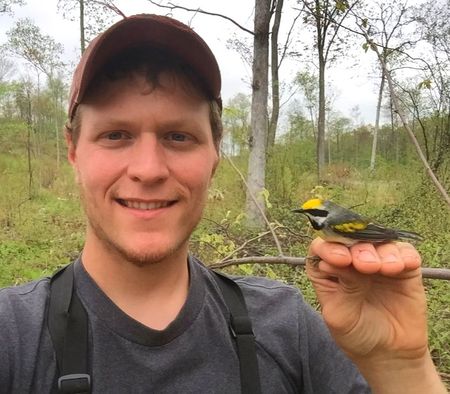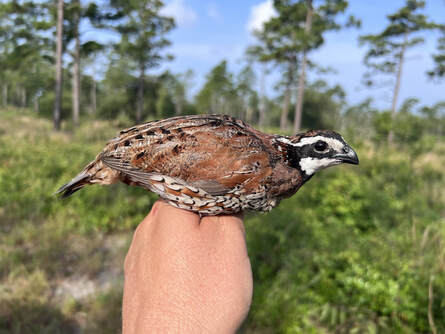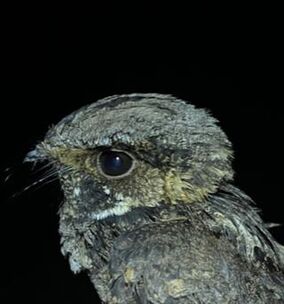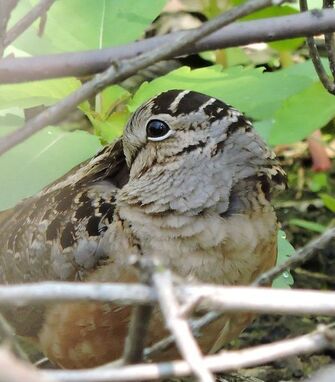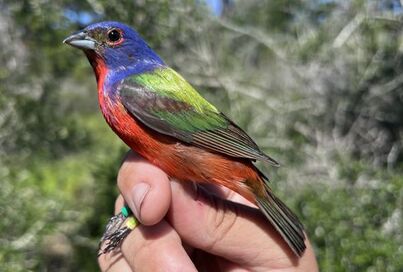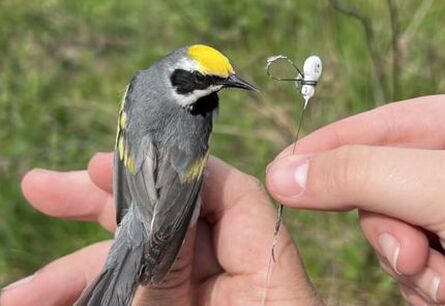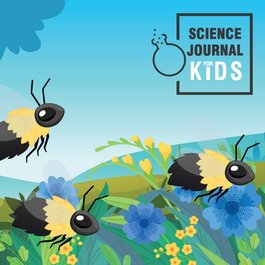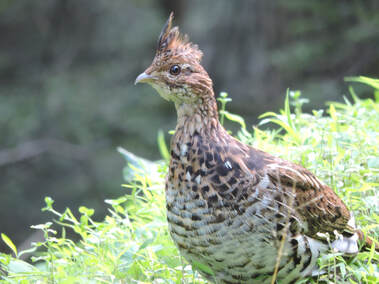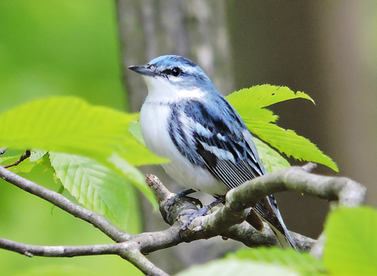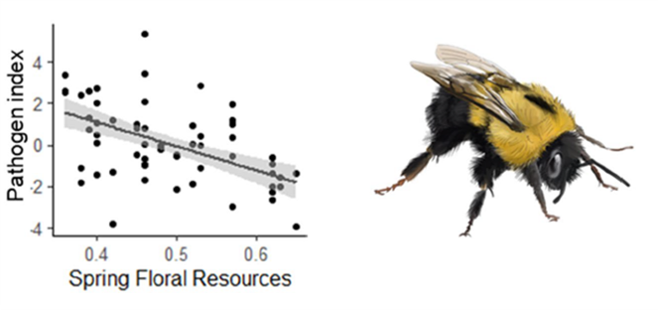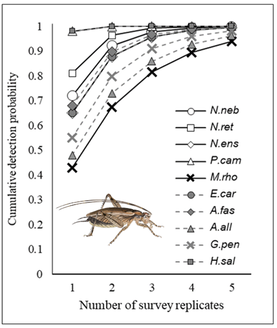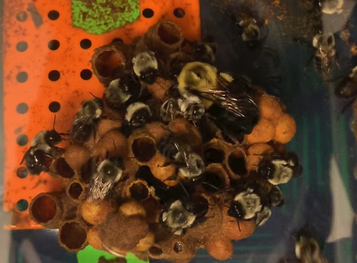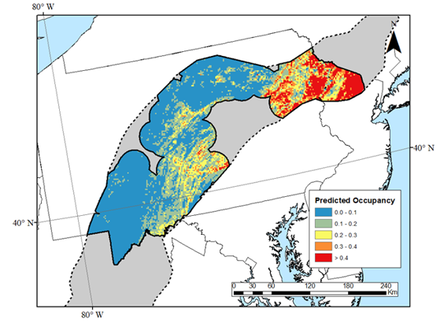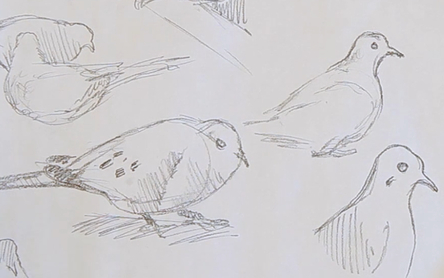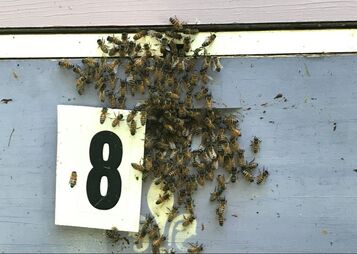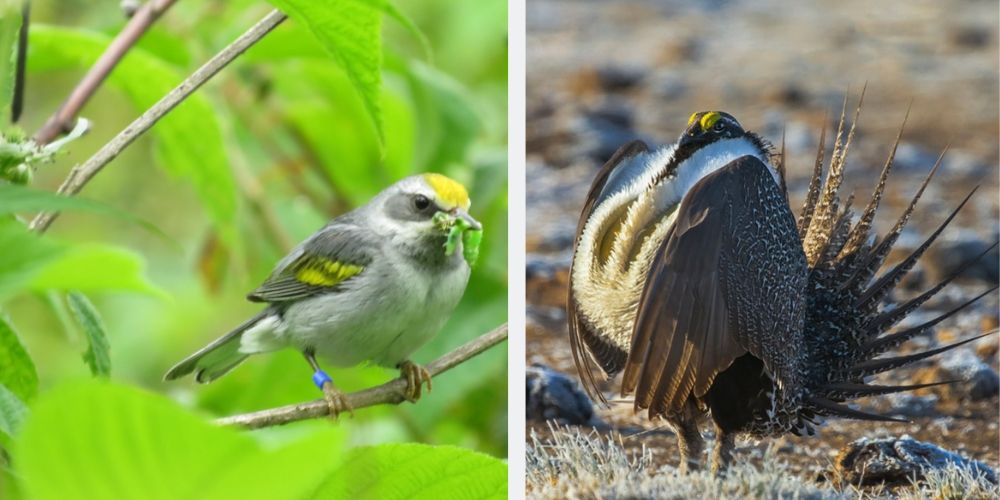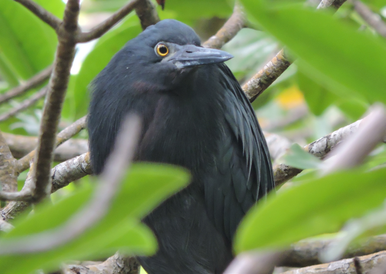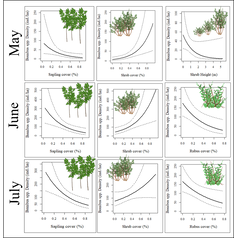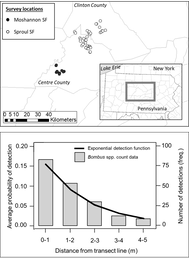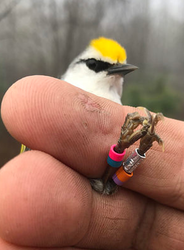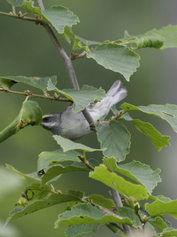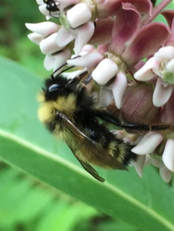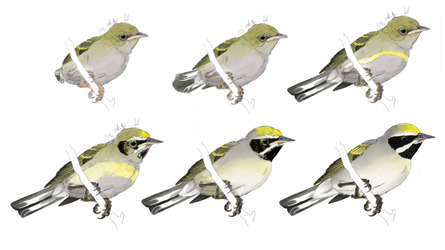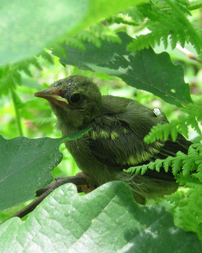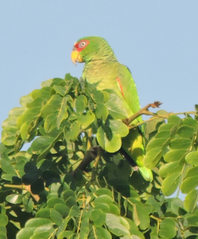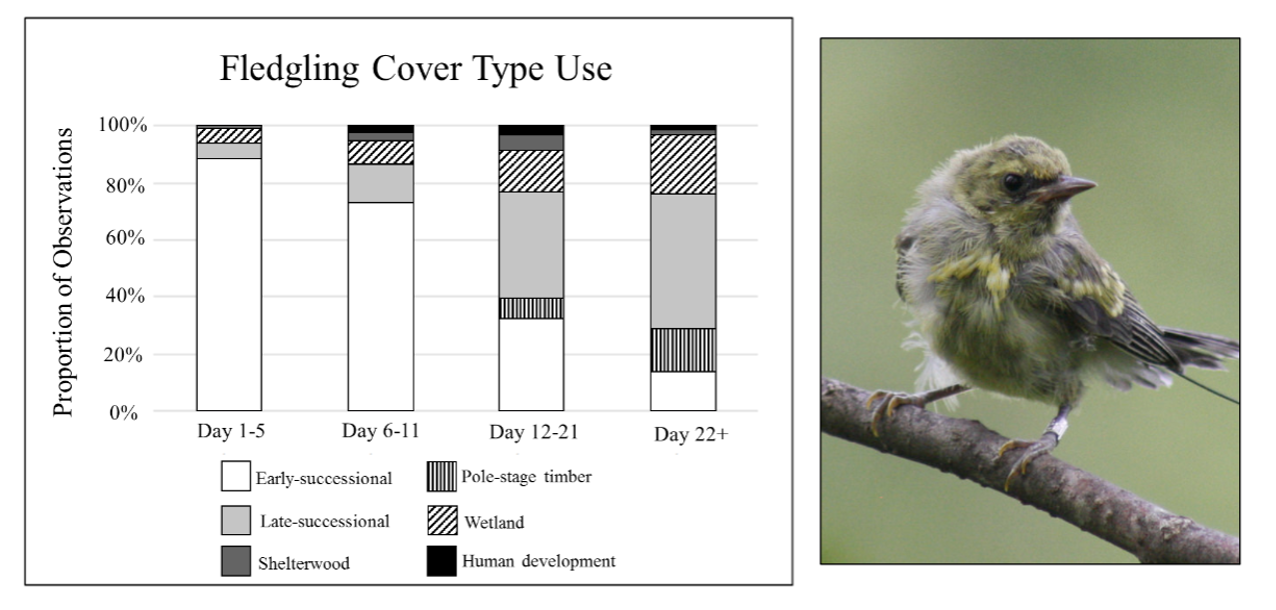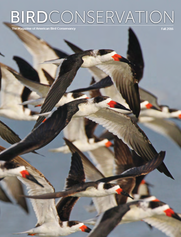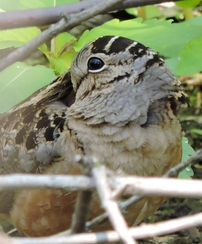Conservation BiologistI study the ecology and conservation of native wildlife with a particular focus on species of conservation concern. I enjoy working on projects that push the boundaries of ecological theory, while also bearing direct application to active conservation challenges. The majority of my work involves quantifying population metrics (e.g., occupancy, abundance, survival, reproduction, etc.) and relating these metrics to components of habitat quality (e.g., microhabitat, landscape, etc.). Ongoing projects include: 1) understanding patterns of movement and survival in Northern Bobwhites, 2) Assessing habitat full lifecycle ecology of Eastern Whip-poor-wills, and 3) assessing the role of timber management in the conservation of disturbance-dependent birds like Golden-winged Warblers.
Assistant Professor University of Kentucky Department of Forestry and Natural Resources --------------------------------------- email: darin.j.mcneil -at- uky.edu iNaturalist: @djm GitHub: darinjmcneil |
News
Note: As I was moving around NC and KY over the last couple years, updates were not published so I have pasted them now (December, 2023) retroactively to provide some updates!
|
General Update: Fall 2023
Fall 2023 has had a lot of interesting activities now that we are finally getting settled into UK. We completed our fall bobwhite trapping - in record time (>200 collars deployed in < 2 weeks!). Autumn also presented her work at The Wildlife Society's national meeting in Louisville, KY. McNeil gave seminars for Entomology, Forestry, and Donovan Forum. Undergraduate Will Gibson has spearheaded a new project on Cooper's Hawks/Sharp-shinned Hawks. Finally, we have obtained all the permits to begin building the UK-FNR museum specimen collection on native birds!
|
|
General Update: Spring 2023
Spring 2023 brings a new grad student into the lab - welcome, Nicole Notarianni! For her project, we completed out first field season catching Eastern Whip-poor-wills. We also finished a field season catching Golden-winged Warblers for Amber Roth's work at U. Maine. Furthermore, we continued monitoring bobwhite demography for Autumn's project. Finally, we have a cool little project in the works studying habitat ecology of the six-lined racerunners.
|
|
General Update: Academic Year 2022-23
We have finally arrived in Kentucky to begin the new McNeil Lab at UK! Coming with me is my first graduate student - Welcome, Autumn Randall! Autumn is studying demography and movements of Northern Bobwhites. Upon arriving at UK, I gave a departmental seminar on avian conservation/management in eastern forests. We also developed a new project on nectar sampling study to be implemented next year. Two new papers published (one on woodcock, another on LiDAR) and we also continued our Northern Saw-whet Owl project collaborating with Chris Kelly (NCWRC)
|
|
General Update: Spring 2022
At the beginning of 2022, we kicked off a new project studying Northern Bobwhite demographic rates and movements. Excitingly, I pursued a new opportunity to transition to a new faculty job at University of Kentucky, though I was sad to leave UNCW. I will bring my UNCW projects with me to UK and continue collaborating with folks at UNCW/Wilmington. One effort we are developing is on Painted Buntings!
|
|
General Update: Summer/Fall 2021
In spring of 2021, I began a new post-doc at University of Maryland under the direction of Andrew Elmore and Matt Fitzpatrick. At UMD, I worked on developing a new LiDAR paper. However, shortly after starting that post-doc, an opportunity to start as an Assistant Professor at University of North Carolina Wilmington popped up (and I accepted). Work at UNCW brought exciting new collaborations and continuation of past work - including deploying and recovering nanotags on Golden-winged Warblers and monitoring for Northern Saw-whet Owls.
|
Really Cool 'Kids' Version of our Scientific Reports Paper!!
April, 2021
|
Very cool -- I have been working with the great folks from Science Journal for Kids on developing a 'Kids' version of our Bumble bee paper published in Scientific Reports this past fall. I have to say, it was a joy working with Sci J. for Kids folks on this - they helped me and my coauthors to convert our rigorous scientific article into very digestible article that can be shared with middle-school aged children. The kids version of our article can be found here -- there is even a lesson plan, activities, etc.! A very fun experience.
|
Project Upland Podcast Interview - Nick Larson & D.J. McNeil
March, 2021
|
This is just a short update to share a podcast interview I recently did with Nick Larson from Project Upland!
The podcast episode (#137) covers a breadth of topics with a focus on the impacts of forest management on game birds like Ruffed Grouse and American Woodcock (among others). Some of these ideas are not new to game bird hunters but Nick and I discuss how forest disturbance (i.e., timber management) can create a more holistic ecosystem for birds and hunters alike! Click here to listen to the podcast (length: 1:03hr) |
Fiss et al. Golden-winged Warbler Fledgling Paper - Published in Condor!
January, 2021
|
Our new publication (lead by songbird research superstar Cam Fiss [SUNY-ESF]) on Golden-winged Warbler post-fledging habitat selection has now been published in Condor - Ornithological Applications!! In recent years, the Golden-winged Warbler has increasingly become the flagship species for forest management and improved forest health. In our paper, we monitored post-fledgling habitat selection and movement patterns (via radio telemetry) for Golden-winged Warbler fledglings in two Pennsylvania landscapes: Pocono Mountains and Pennsylvania Wilds. We found stark differences in habitat selection patterns -- check out the paper here for details!
|
New Position at University of Maryland's SESYNC - Elmore & Fitzpatrick Labs
December, 2020
|
More exciting news -- I have just accepted a new postdoc position at University of Maryland working with Andrew Elmore and Matt Fitzpatrick! At UMD (SESYNC), I'll be working with a team of researchers to connect LiDAR data to information on dynamic forest management targeted at birds of conservation concern (like Cerulean Warblers!). Although I will very much miss all of my friends from Penn State (especially my mentors Christina, Heather and Sarah), I am excited to embark on a new chapter in my career -- with a return to bird work!
|
New Publication: Floral Resources Predict Disease Loads in Bumble Bees
November, 2020
|
Exciting news! Our two-year study on bumble bee (Bombus impatiens) disease ecology is now published in Nature - Scientific Reports! In the paper, we collected hundreds of bees across variable landscapes across Pennsylvania and examined disease-habitat relationships. Bees with more exposure to exotic honey bees and those in landscapes lacking floral resources had more disease. Check out the paper here or this press release from Penn State for details!
|
Penn State Press: 'Singing in the Suburbs' Interview
October, 2020
This is simply a short update to share that Penn State interviewed both Christina Grozinger and myself about our new Journal of Insect Conservation paper on crickets and katydids: "Singing in the Suburbs" where we used a novel survey technique to study these charismatic insects of conservation concern. Read the interview here!
Night-singing Orthoptera Habitat Ecology: Accepted in J. of Insect Conservation!
September, 2020
|
Just in time for fall katydid singing season, our 2019 study ("Singing in the Suburbs"; McNeil & Grozinger) was just accepted in the Journal of Insect Conservation! In our new paper, we developed a new, low-cost method for surveying cricket and katydid (Orthoptera: Ensifera) populations that can be widely implemented to assess species habitat needs and site occupancy. Not only did we pioneer a new method for studying these insects, but we also implemented our method across an urban-to-rural gradient in central Pennsylvania. This allowed us to quantify, for the first time, the habitat needs for many species and entire communities of night-singing insects.
|
2020 Field Season: Bumble Bee Demographic Monitoring
June - August, 2020
|
Does landscape diversification benefit pollinator populations? Or might insects like bumble bees thrive equally in diverse/homogenous landscapes? During the 2020 field season, I have raised queen bumble bees (like in the photo on the right) and am monitoring colony dynamics in different habitat types! This field season has been a whirlwind of learning new skills including bumble bee rearing, beekeeping, portable electric fence development/use, and many other field/lab skills. Stay tuned for development on this project!
|
Two new papers: Biological Conservation & Restoration Ecology!
March, 2020
|
I am happy to announce that I have two new papers in-press! The first, in Biological Conservation, assesses the extent to which habitat restoration efforts for imperiled songbirds might be dependent upon local demography (e.g., nest success, fledgling survival, etc.) AND whether this dependency is, itself, context specific. The second paper is in Restoration Ecology and assesses the habitat factors (from micro-habitat to landscape conditions) that drive restoration outcomes for a national habitat restoration program to help Golden-winged Warblers. This figure is from the latter paper - check my 'publications' page for PDFs of these papers!
|
Presentation at Annual Wildlife Society Conference (Reno, Nevada)
October, 2019
|
The young forest group from Pennsylvania (Larkin, Fiss, Mathis) and I all went to the National Conference of the Wildlife Society (TWS) this week in Reno, Nevada! We absolutely 'cleaned house' with five talks ranging from community ecology, conservation planning, and pollinator resource tracking! My talk was titled "Comparing Golden-winged Warbler Full Season Productivity and Occupancy Across Four Regions of the Breeding Distribution" and was well-received! We also got to sneak away and visit Mt. Rose and Lake Tahoe - definitely coming back to NV at some point!
|
Cornell Lab of Ornithlogy - Nature Journaling Interview
September, 2019
|
This one is a little different (but fun!). I recently did an interview on the topic of nature journaling and field sketching for the Cornell Lab of Ornithology's Nature Journaling course (here). Although I have not personally taken the course, I would definitely do so if I had the time. For more information, please visit birds.cornell.edu
|
Interview with Technical.ly on Beescape
|
September, 2019
I recently gave an interview with the folks at Technical.ly about the Beescape app I've been helping to develop at Penn State (Christina Grozinger's Lab) to help US pollinator populations -- that includes both managed and wild bee populations! See the link below and, of course, visit www.beescape.org for more information!
Interview: here |
Insightful Article Comparing Golden-winged Warblers and Sage Grouse
|
August, 2019
Check our this article recently produced by the Natural Resource Conservation Service about the importance of private lands to Golden-winged Warblers and Greater Sage Grouse! It's very interesting to see the many parallels one can draw between the conservation of this migratory songbird with a sagebrush-dependent game bird (click here for access) Photo: J. Larkin (left) and Rick McEwan (right) |
Melanistic Green Heron Paper Now Online!
|
January, 2019
Our melanistic Green Heron paper is now online (here)! Sightings of Green Herons from the Caribbean suggest that, perhaps there exists an overlooked plumage color polymorphism in this cosmopolitan species! An example of a melanistic green heron we observed can be seen on the right. This was a fun little paper my colleagues and I wrote during a trip to Utila, Honduras. I'm excited to have illustrated the plates for this paper (Fig. 4)! |
Presentation at 2018 Annual American Society of Entomologists (ESA)
|
November, 2018
The Cornell/IUP crew is on the move, once again! Codey Mathis and I visited Vancouver for the 2018 Annual meeting of the American Society of Entomologists! I presented our ongoing work on native bee communities within restored early-successional habitats. The talk was entitled "Dynamic Habitat Associations of Native Bees within Early-successional Forests of Pennsylvania" and seemed to go over well with the audience. This has been a fantastic conference with good networking opportunities and lots of ideas to consider in my own upcoming work! |
Bumblebee Detection Paper Accepted in Journal of Applied Entomology
|
October, 2018
Although unrelated to my PhD Dissertation, we got a paper on bumblebee density estimation and detection probability accepted to Journal of Applied Entomology (reference here). Detection probability for bumble bees varied with time of day, observer, and even the habitat itself (i.e., grassy, open areas had higher detection probability than dense vegetation). This method is an improvement over more classic methods like netting surveys (also compared in the paper) and promises to benefit those surveying for species like bumble bees. Download: here |
D.J. and Cam both Publish in Wilson Journal of Ornithology!
|
September, 2018
A double-whammy -- Cam Fiss and D.J. both published in WJO this month with two upcoming manuscripts in press (references here). Cam's paper details the devastating effects of a hail storm on an imperiled breeding aggregation of Golden-winged Warblers, a phenomenon expected to become more common in light of climate change. My paper (Cam is a co-author) details the occasional influence of male polygamy on movement patterns in birds using a Brewster's Warbler as an example. It is our hope that polygamy is explicitly considered by other studies in the future! Fiss et al. 2019 download: here ...and McNeil et al. 2019 download: here |
2018 Field Work: Birds, bees, trees, and more!
|
May-August, 2018: PA, MD, NJ, WV and MN
Field work this summer will be all across the Central Appalachians, as in past years, contributing to the Larkin Lab dataset on Golden-winged Warbler response to habitat management. This year we will band dozens more males as part of our demographic study as well as collecting data on other taxa like Lepidoptera, Bombus spp., and lots of other wildlife! Here's a photo from the field of a female GWWA probe-and-gaping a witch hazel leaf-roller - GWWA are one of the few birds to forage in this way! |
Presentation at 74th Annual Ass'n of Fish & Wildlife Agencies (NEAFWA)
|
April, 2018: Burlington, Vermont
The Cornell/IUP crew is on the move! Cam Fiss, Jeff Larkin and I are presenting at the 74th Annual NEAFWA in Burlington Vermont! Surprisingly, I get the opportunity to present two talks: 1) "Evaluating Native Pollinator Density in Regenerating Timber Harvests Practices Associated with NRCS-WLFW" and 2) "American Woodcock Occupancy and Abundance on managed lands". I think I am finally getting the hang of thinking/talking about pollinators and the opportunity to talk about woodcock was very welcome! |
NRCS Video: Thinning Forests to Save Birds
|
April, 2018
Check out this very cool video produced by the Natural Resource Conservation Service about habitat management for Golden-winged Warblers and Cerulean Warblers. It was a huge honor to be included in this video -- so exciting for the opportunity to be included in this very important work. Projects like those outlined here may hold the key to maintaining populations of birds, particularly disturbance-dependent species like Golden-wings and Ceruleans. |
|
Ornithology Seminar at Cornell Lab of Ornithology
|
October, 2017
Come to Ornithology Seminar at the Cornell Lab of Ornithology (Corson-Mudd) for a discussion of my ongoing work on fledgling ontogeny! Many studies have been conducted on the post-fledging period in songbirds of eastern North America but most have focused on coarse details like habitat and survival. Could there be more to the picture? |
2017 Field Work: Species response to management and songbird behavior
|
May-August, 2017: PA, MD, NJ, MN, and WI
Field work this summer will be all across the Central Appalachians, as in past years, contributing to the Larkin Lab dataset on Golden-winged Warbler response to habitat management. This year's crew is bigger than ever - a very good bunch. Field work focus this year will be collecting as much point count data as possible across our five focal states (nearly 1,000 survey locations!) and as much demographic data on Golden-winged Warblers as we can collect. Check out this fledgling Golden-winged Warbler wearing a radio transmitter (barely visible on the bird's back)! Photo: R. E. Veasley |
2017 Field Work: Nonbreeding Golden-winged Warblers in Honduras
|
Jan-February, 2017: HN, Central America
Field work can't ALL be fun temperate work -- occasionally we must tear ourselves away from a snowy landscape to help in tropical environments. I spent six weeks in Honduras helping Dr. Ruth Bennett collect geolocators from non-breeding GWWA on the wintering grounds. It is quite clear that GWWA on the nonbreeding grounds are substantially more difficult to capture than those on the breeding grounds! Oh, and sometimes you have to see less attractive species like this (->) white-fronted parrot. Tropical field work is so difficult! |
Natural Resources Conservation Service: 'Conservation Insights'
|
December, 2016
Take a look at this report recently produced by the Natural Resource Conservation Service about our ongoing research! In their 'Conservation Insights' document, they detail some of the cool ongoing work in the lab including nest success of warblers, fledgling movements, and many other fun study components! (click here for access) |
ABC's : Bird Conservation Features our Geolocator Research!
|
October, 2016
To follow up on their recent video production, the American Bird Conservancy wrote a cool paper about our geolocator deployment and recovery effort. As before, our Golden-winged Warbler work is showcased along side the stellar data collection effort by Doug Raybuck (et al.) on Cerulean Warblers. This article details nicely the challenges of 'day-to-day' capture of birds that have already been captured once before and have become quite wary of our efforts! (click here for access) |
American Bird Conservancy Video: Mapping Migration
|
September, 2016
Take a look at this video recently produced by the American Bird Conservancy featuring the work funded, in part, by ABC, NRCS, IUP, and others! Very exciting to be working with a variety of great folks, all working together to solve the mysteries of migration. As we know, understanding the full avian lifecycle is critical for the conservation of Nearctic-Neotropical migrants like Golden-winged Warblers and Cerulean Warblers. |
|
CEAP Avian Training Video Series - Online Now!
|
Fall, 2016
I have posted a series of videos constituting the CEAP Avian Training Video Series. These videos are designed by myself to provide visual and aural tools for field researchers wishing to study eastern forest birds. In these videos, I cover groups of birds (e.g., sparrows, shown) and discuss each individual species including calls, songs, and visual methods of identification. These videos are meant as training tools for my field crews but anyone interested is welcome to them! |
|
2016 Field Work: Woodcocks, Warblers, and Enormous Vegetation Plots!
|
May-August, 2016: PA, MD, NJ, MN, and WI
Like 2015, field work this summer will be all across the Central Appalachians and Great Lakescontributing to the Larkin Lab dataset on Golden-winged Warbler and American Woodcock response to habitat management! It's a big crew this year and more sites than ever (>700!) Field work focus this year will be collecting as much point count data as possible across our five focal states and as much demographic data on Golden-winged Warblers as we can collect. We are shifting fledgling surveys from the Pocono Mountains to the Pennsylvania Wilds. Look out, Sproul State Forest - we're coming! |
